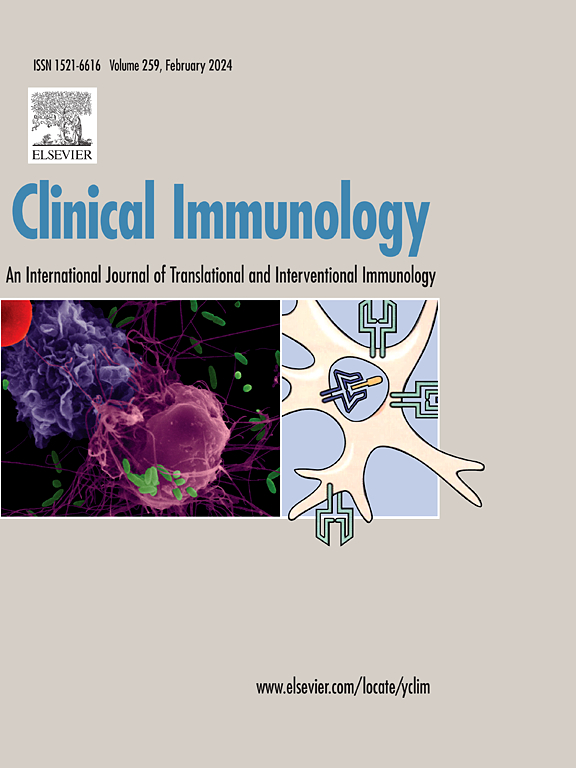CD8+ T细胞的高反应性和IL-3的高表达与Long-COVID的发生和严重程度相关
IF 3.8
3区 医学
Q2 IMMUNOLOGY
引用次数: 0
摘要
感染 SARS-CoV-2 后,一些人会出现持续 3 个月以上的 Long-COVID 综合征。我们分析了长COVID患者、感染SARS-CoV-2后无持续症状的对照组和无感染史的非感染供血者的血液样本。长COVID患者表现出明显的T细胞过度激活迹象,主要是CD8+ T细胞亚群,CD25表达量高出4倍,效应记忆T细胞高出2倍。在多克隆 T 细胞刺激后,我们发现 Long-COVID 的 CD25 上调幅度增加了 2 倍,IL-3 释放量增加了 7 倍。细胞内染色显示,Long-COVID 中表达 IL-3 的 CD8+ T 细胞增加了 5 倍,而 GM-CSF、IFN-γ 和 IL-2 的上调幅度则小得多。这些变化与 Long-COVID 的严重程度相关,并在感染后持续长达 18 个月。我们的数据揭示了长COVID患者CD8+ T细胞明显而持久的高活化和高反应性,因此有必要对长COVID患者进行T细胞免疫抑制试验。本文章由计算机程序翻译,如有差异,请以英文原文为准。
Hyper-reactivity of CD8+ T cells and high expression of IL-3 correlates with occurrence and severity of Long-COVID
Following SARS-CoV-2 infection, some individuals develop Long-COVID-syndrome lasting for more than 3 months. We analyzed blood samples from patients with Long-COVID, controls without persistent symptoms following SARS-CoV-2-infection and non-infected donors without a history of infection. Long-COVID patients showed clear signs of T cell hyper-activation predominantly in the CD8+ T cell subset with a 4-fold higher expression of CD25 and 2-fold more effector-memory T cells. Following polyclonal T cell stimulation, we found a 2-fold stronger upregulation of CD25 and a 7-fold higher release of IL-3 in Long-COVID. Intracellular staining revealed 5-fold more IL-3-expressing CD8+ T cells in Long-COVID, while GM-CSF, IFN-γ and IL-2 were much less upregulated. These changes correlated with the severity of Long-COVID and persisted for up to 18 months after infection. Our data reveal a pronounced and long-lasting CD8+ T cell hyper-activation and hyper-reactivity in Long-COVID and speak for a trial of T cell-immunosuppression in patients with Long-COVID.
求助全文
通过发布文献求助,成功后即可免费获取论文全文。
去求助
来源期刊

Clinical immunology
医学-免疫学
CiteScore
12.30
自引率
1.20%
发文量
212
审稿时长
34 days
期刊介绍:
Clinical Immunology publishes original research delving into the molecular and cellular foundations of immunological diseases. Additionally, the journal includes reviews covering timely subjects in basic immunology, along with case reports and letters to the editor.
 求助内容:
求助内容: 应助结果提醒方式:
应助结果提醒方式:


